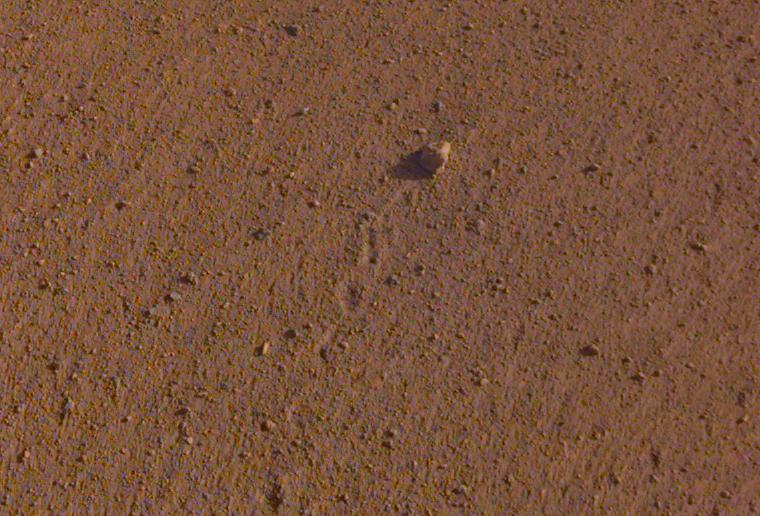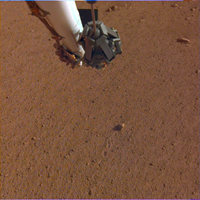
|
Rolling Stones Rock
- Click the image above for a larger view
- Full-Res JPEG (760 x 516) (84.3 kB)
- Full-Res TIFF (760 x 516) (1.2 MB)
Caption:

Uncropped image
Click on the image for larger version
The rock in the center of this image was tossed about 3 feet (1 meter) by NASA's InSight spacecraft as it touched down on Mars on November 26, 2018. The rock was later nicknamed "Rolling Stones Rock" in honor of The Rolling Stones.
A little larger than a golf ball, the rock is about 2.2 inches (5.5 centimeters) in diameter and 1 inch (2.4 centimeters) in height. A series of 10 or so divots marks the rock's course after being set in motion by the landing. It's the farthest NASA has seen a rock roll after landing a spacecraft on another planet.
Though fitting, "Rolling Stones Rock" is not an official designation by the International Astronomical Union, which is responsible to approving the names given to geographical and geological features on other planets.
This image, which has been cropped, was taken by the Instrument Deployment Camera (IDC) on InSight's robotic arm. The uncropped image is provided as well.
Background Info:
JPL manages InSight for NASA's Science Mission Directorate. InSight is part of NASA's Discovery Program, managed by the agency's Marshall Space Flight Center in Huntsville, Alabama. Lockheed Martin Space in Denver built the InSight spacecraft, including its cruise stage and lander, and supports spacecraft operations for the mission.
A number of European partners, including France's Centre National d'Études Spatiales (CNES) and the German Aerospace Center (DLR), are supporting the InSight mission. CNES provided the Seismic Experiment for Interior Structure ( SEIS ) instrument to NASA, with the principal investigator at IPGP (Institut de Physique du Globe de Paris). Significant contributions for SEIS came from IPGP; the Max Planck Institute for Solar System Research (MPS) in Germany; the Swiss Federal Institute of Technology (ETH Zurich) in Switzerland; Imperial College London and Oxford University in the United Kingdom; and JPL. DLR provided the Heat Flow and Physical Properties Package ( HP3 ) instrument, with significant contributions from the Space Research Center (CBK) of the Polish Academy of Sciences and Astronika in Poland. Spain's Centro de Astrobiología (CAB) supplied the temperature and wind sensors.
Cataloging Keywords:
| Name | Value | Additional Values |
|---|---|---|
| Target | Mars | |
| System | ||
| Target Type | Planet | |
| Mission | InSight | |
| Instrument Host | InSight Lander | |
| Host Type | Lander | |
| Instrument | Instrument Deployment Camera (IDC) | Heat Flow and Physical Properties Package (HP3), Seismic Experiment for Interior Structure (SEIS) |
| Detector | ||
| Extra Keywords | Color | |
| Acquisition Date | ||
| Release Date | 2019-08-23 | |
| Date in Caption | 2018-11-26 | |
| Image Credit | NASA/JPL-Caltech | |
| Source | photojournal.jpl.nasa.gov/catalog/PIA23349 | |
| Identifier | PIA23349 | |
